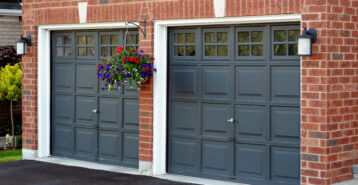Are you doing a windows project?
Modernize can pair you with three to four pros in your area, so you can compare options and save time and money.
In today’s tech-savvy world, homeowners are constantly seeking innovative solutions to elevate their living spaces. Among the most groundbreaking advancements in modern home design are smart glass windows. These aren’t your average panes; they meld technology with functionality, providing unparalleled control over privacy, light, and temperature. But with such sophisticated features comes an equally important question: How much do these futuristic windows cost? Dive in as we break down the pricing and factors influencing the cost of smart glass windows.
Revolutionizing Home Efficiency: The Magic of Smart Windows
Windows play a major role in your home’s energy use and efficiency. Where traditional windows can fall short, smart windows can provide homeowners with innovative options to more effectively manage how much light enters the home and when.
These Wi-Fi-connected smart glass surfaces are, essentially, windows with electric shading. They are equipped with environmental sensors that can read room occupancy, weather, and sunlight. Their louvers adjust tints to allow in more solar heat when you need it and shade your home when it’s hotter out. That means you’ll never have to reach to adjust the shades ever again.
Here’s a breakdown of the kinds of smart window products on the market right now, and the pros and cons of opting for smart window technology.

Smart Windows Cost
Smart windows are costly compared to traditional glass, averaging between $50 and $150 per square foot. Compare this to $10 to $15 per square foot for regular window glass. The final cost will depend on which type of smart window you want, which you can explore below.
Types of Smart Windows
There are several options of smart windows to select from, each offering unique functionality. When deciding which option is right for your home, you’ll want to consider what room(s) the windows are located in, window sizes, the type of windows you’ll be replacing, how much light and heat you want to block, your project budget, and any privacy needs.
Electrochromic Glass
These windows use electricity to offer homeowners the ability to control how much heat and light can pass through.
The system requires a small burst of electricity to alter the opacity but no additional electricity is needed to maintain the set level. Electrochromic glass can fully tint in a matter of minutes.
Photochromic Window Tint
Also known as transitional film or smart window film, photochromic tint is altered by its exposure to UV rays. During daylight, photochromic tint renders a darker shade to provide maximum UV shade. At night, the tint transitions to appear clear and transparent.
This type of technology is commonly seen in optical lenses that change shades depending on if the wearer is inside or outdoors.
Thermochromic Glass
Similar to photochromic tint, the tint of thermochromic glass is dictated by outside elements — in this case, heat. When the external temperature rises about the transition threshold, it activates the thermochromic filter on the glass, transitioning the tint within minutes.
Find the Right Contractor for Your Windows Project
Whether you’re ready to begin your project now or need some expert advice, our network of contractors are here to help. With a few simple questions, we’ll find the best local professionals for you
Suspended-Particle Glass
This type of glass falls into a larger category of technology known as suspended-particle devices (SPDs). This type of glass leverages nanoparticles that are suspended in liquid. When voltage is applied to these particles, they align and allow light to pass through. When electricity is removed, the particles become randomly organized, blocking and absorbing light.
The amount of light allowed to pass through varies on the voltage and can be either manually or automatically tuned to control light, glare, and thermal transmittance — giving full control to the homeowner.
Micro-Blind Smart Glass
Micro blinds are thin, rolled metal blinds on the window glass that can be controlled using electricity. When no voltage is applied, the micro blinds are rolled, allowing for light to enter the home.
However, when electricity is applied, an electric field forms between the glass and the blinds. This allows the blinds to unroll, flatten, and begin blocking out light. They can also be adjusted in a similar way to regular blinds to better control light and add privacy. This is typically what people mean when they think of windows with electric shading, and it is an excellent option.
Polymer-Dispersed Liquid-Crystal Glass
Commonly seen in bathrooms, office environments, and hospitals, this type of smart window reduces outside light through the hardening of dissolved liquid crystals on the glass. These droplets scatter the light and give off a milky appearance.
When electricity is applied, the crystals align, allowing the passage of light.
Benefits of Smart Windows
Regardless of the type of smart window you opt for, there are some common, clear benefits to their installation. But there is also a common downside that has plagued many smart home products over the years.
-
Pros
- Energy Efficient
- Convenient
- Provides privacy
-
Cons
- Cost can be prohibitive for many homeowners
- Few potential installers
Pros of Smart Windows:
- Energy Efficiency: Your home’s windows are one of the main points where inside air is lost and outside air and temperatures are allowed in. Smart windows can reduce interior air loss and limit the amount of light passing into your home. Most experts agree smart windows have the potential to save you excess energy, which means lower utility bills — in some instances, as much as 30%.
- Convenience: Smart windows have the potential to eliminate your need for window treatments, blinds, or shades They also allow for more control over how much light you allow into your home and when.
- Privacy: While exterior-facing smart windows might provide privacy comparable to blinds or curtains, smart windows within rooms (such as the bathroom or a home office) can provide privacy in areas where blinds or curtains might not be feasible.
Cons of Smart Windows:
- Cost: Since smart windows are a new, evolving technology, they come with a price to match. That price almost always exceeds that of curtains, blinds, stick-on tints, or other older, more conventional methods of covering windows. Some experts expect it might take a decade (or longer) for smart window costs to become more attainable for the average household.
- Few potential installers: Smart windows are still an evolving industry and cost-prohibitive for many homeowners. As such, it can be daunting to find a company that works with owners of single-family homes.
Selecting the Right Smart Glass Windows Company for You
Selecting the right company for your smart windows installation is a crucial step in enhancing your home’s energy efficiency and convenience. While the allure of smart glass windows is undeniable, not all providers are created equal. It’s essential to research and choose a company with a strong track record, positive customer reviews, and a reputation for using high-quality materials. Additionally, ensure they offer comprehensive warranties and post-installation support. Taking the time to consult with multiple companies, asking about their experience and checking their references, can make all the difference in ensuring a seamless integration of this innovative technology into your home.
Some American-based manufacturers you can also reach out to for quotes on availability and pricing include Smart Glass Country, American Switch Glass, Polytronix, and Innovative Glass.
Looking to start your smart windows project? The pros at Modernize can connect you with local window contractors.
Find the Right Contractor for Your Windows Project
Whether you’re ready to begin your project now or need some expert advice, our network of contractors are here to help. With a few simple questions, we’ll find the best local professionals for you
Reviews from Real Homeowners
Welcome to Homeowner Resources! We are the Modernize blog. Modernize pairs more than 3 million homeowners a year with pre-vetted contractors in their area. This blog started because we believe homeowners should know everything about their homes, from how their HVAC works to which front door colors they might love. On Homeowner Resources, you can find information on every part of your home, right down to how you can negotiate with contractors to get the best price. Here's more about the blog.
Need a contractor? Learn more about how Modernize finds the right pro for you.







